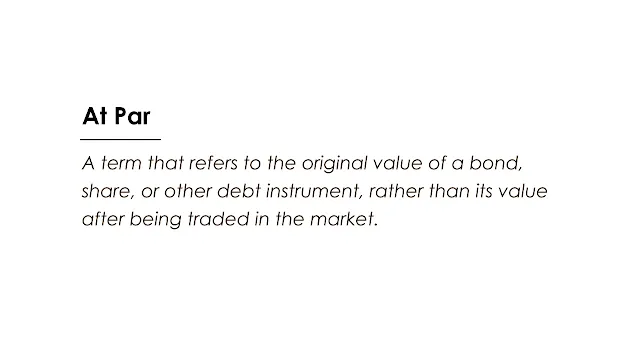 |
| Image: Moneybestpal.com |
At par is a term that refers to the original value of a bond, share, or other debt instrument, rather than its value after being traded in the market. It is sometimes referred to as face value or nominal value. When a bond is issued at par, the issuer gets paid the bond's face value. For instance, the issuer receives $1,000 from the bondholder when a bond with a face value of $1,000 is issued at par.
A bond's market price may be higher, lower, or equal to par depending on a number of variables, including the current interest rate, the remaining time to maturity, the issuer's credit rating, and the supply and demand for the bond. A bond's yield, or the annual return an investor receives from owning the bond, is influenced by the bond's market price. A bond's yield and price are negatively correlated: when the price increases, the yield decreases, and vice versa.
The yield on a bond that trades at par is equal to the coupon rate, which is the set annual interest rate that the bond issuer pays to the bondholder. For instance, if a bond has a $1,000 face value, a 5% coupon rate, and trades at par, it indicates that the bondholder will earn $50 annually (5% of $1,000), and will receive $1,000 back at maturity. This bond's yield is also 5%, matching the market interest rate.
The yield on a bond that trades above par is lower than the coupon rate. In other words, the bondholder must pay more than the bond's face value in order to earn a fixed interest rate that is greater than the going rate. For instance, if a bond has a $1,000 face value, a 5% coupon rate, and trades at 110 (112% of $1,000), it means that the bondholder must pay $1,100 in order to earn $50 annually and will receive $1,000 back at maturity. Because the bondholder pays more than what he or she ultimately receives, the yield on this bond is less than 5%.
The yield on a bond that trades below par is greater than the coupon rate. For a fixed interest payment that is less than the market interest rate, the bondholder must pay less than the bond's face value. If a bond, for instance, has a $1,000 face value, a 5% coupon rate, and trades at $90 (90% of $1,000), it means that the bondholder must spend $900 to receive $50 annually and will receive $1,000 at maturity. Because less is paid by the bondholder than what is received overall, the yield on this bond is more than 5%.
Understanding at par is crucial since it enables investors to compare various bonds and gauge their relative attractiveness. An investor can assess if a bond is overvalued or undervalued in comparison to other bonds with similar qualities by knowing the par value, coupon rate, market price, and yield of the bond. In general, investors choose bonds that trade below par because they provide higher yields and the potential for capital gains. But while choosing bonds, investors must also take into account other aspects including credit risk, liquidity risk, inflation risk, and reinvestment risk.
As of September 29, 2023, there were a number of municipal bonds in the United States with different rates, according to recent data1. For instance, a bond issued by the University of California was trading at 91.6041 and had a yield of 5.050%. A 5.663% yield was being offered on another San Francisco bond, which was priced at 103.6471. This shows that while certain municipal bonds in the United States are trading over par, others are trading below par, offering greater yields than their coupon rates as a result of their low market prices.
Due to these market conditions, investors have the chance to buy bonds at a discount or a premium and potentially earn yields that are different than the bond's coupon rate. However, like with any investment, it's crucial for investors to carefully evaluate the risks involved prior to making a decision.
Please be aware that this is a simplified explanation and that other elements, such as the issuer's creditworthiness, the bond's maturity date, and market liquidity, might affect the actual bond pricing. It is always advised to seek the advice of a financial expert or do extensive study before making an investment.
